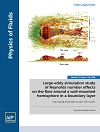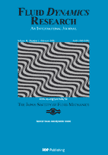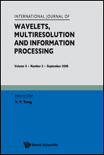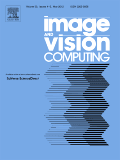
JOURNAL OF FLOW VISUALIZATION AND IMAGE PROCESSING
Scope & Guideline
Decoding Complex Flows with Cutting-Edge Image Processing
Introduction
Aims and Scopes
- Fluid Dynamics Research:
The journal publishes studies on various aspects of fluid dynamics, including experimental, theoretical, and computational investigations. Research on flow behavior in different regimes and under various conditions is a core focus. - Visualization Techniques:
A significant emphasis is placed on the development and application of visualization techniques to better understand complex fluid-thermal phenomena. This includes advanced imaging methods like high-speed imaging, schlieren techniques, and augmented reality. - Image Processing Methodologies:
The journal covers advancements in image processing algorithms tailored for fluid mechanics applications. This includes machine learning approaches, computer vision techniques, and algorithms for noise reduction and feature extraction. - Multidisciplinary Applications:
Research presented in the journal often intersects with various disciplines, including engineering, biology, and environmental science, showcasing the diverse applications of flow visualization and image processing. - Innovative Experimental Techniques:
The journal highlights novel experimental setups and methodologies that enhance data collection and analysis in fluid mechanics, contributing to improved accuracy and understanding of flow phenomena.
Trending and Emerging
- Artificial Intelligence in Fluid Dynamics:
The integration of artificial intelligence, particularly machine learning algorithms, is on the rise. This trend is evident in the development of more sophisticated image recognition and analysis techniques, enhancing the understanding of fluid behavior. - Real-Time Visualization and Analysis:
There is a growing emphasis on real-time visualization techniques that allow for immediate analysis of fluid flows. This is crucial for applications in engineering and environmental monitoring where timely data is essential. - Multimodal Biometrics and Recognition Systems:
Emerging research is focusing on the application of flow visualization techniques to biometric systems, indicating an interdisciplinary approach where fluid dynamics intersects with security and identification technologies. - Complex Fluid-Structure Interactions:
Research is increasingly exploring the interactions between fluids and flexible structures, which is vital for applications in various engineering fields, from aerospace to biomedical devices. - Advanced Imaging Techniques:
Recent publications emphasize the adoption of advanced imaging techniques, such as high-speed and 3D imaging, which provide deeper insights into fluid dynamics and enhance the accuracy of experimental studies.
Declining or Waning
- Traditional Fluid Dynamics Theories:
There appears to be a waning interest in classical fluid dynamics theories and models, as more innovative and complex methodologies such as machine learning and computational fluid dynamics gain traction. - Basic Image Processing Techniques:
The journal has seen fewer submissions focusing on basic image processing techniques, as researchers increasingly pursue more sophisticated algorithms and approaches, such as deep learning and neural networks. - Single-Domain Studies:
Research that focuses exclusively on a single domain of flow visualization or image processing is becoming less common, with a growing preference for multidisciplinary studies that integrate multiple aspects of fluid dynamics. - Static Visualization Methods:
There is a noticeable decline in the publication of studies that utilize static visualization methods, as dynamic and real-time visualization techniques are becoming more prevalent in the research community.
Similar Journals

PHYSICS OF FLUIDS
Transforming Research into Fluid SolutionsPHYSICS OF FLUIDS is a premier journal published by AIP Publishing that serves as a vital resource for the fluid mechanics community. With an impressive impact factor and a consistent ranking in the Q1 quartile across multiple related disciplines—including Computational Mechanics, Condensed Matter Physics, Fluid Flow and Transfer Processes, Mechanical Engineering, and Mechanics of Materials—this journal is renowned for disseminating high-quality research in the dynamic field of fluid dynamics. Covering a wide range of topics, from fundamental fluid mechanics to advanced computational modeling, PHYSICS OF FLUIDS plays a crucial role in advancing understanding and fostering innovation in both academic and industrial applications. With its strong reputation and significant readership, this journal is essential for researchers, professionals, and students seeking to stay updated on the latest developments in fluid physics.

JOURNAL OF MATHEMATICAL IMAGING AND VISION
Empowering the Future of Imaging with Mathematical RigorJOURNAL OF MATHEMATICAL IMAGING AND VISION, published by Springer, stands as a significant platform for advancing the fields of applied mathematics, computer vision, and pattern recognition, among others. With an ISSN of 0924-9907 and an E-ISSN of 1573-7683, this esteemed journal is based in the Netherlands and has been contributing to the scholarly discourse since its inception in 1992, with a converged focus through 2024. It has achieved reputable standings within several quartiles, including Q2 rankings across applied mathematics, geometry and topology, and condensed matter physics, reflecting its impact and relevance. Notably, the journal ranks within the top 5% in Geometry and Topology and maintains robust standings in Statistics and Probability. The JOURNAL OF MATHEMATICAL IMAGING AND VISION is dedicated to publishing high-quality research that bridges theoretical perspectives with practical applications, making it an essential resource for researchers, professionals, and students who are exploring the cutting-edge of mathematical imaging and its interdisciplinary applications.

FLUID DYNAMICS RESEARCH
Pioneering Discoveries in Fluid Flow and Transfer ProcessesFLUID DYNAMICS RESEARCH, published by IOP Publishing Ltd, is a pivotal journal dedicated to advancing the understanding of fluid dynamics through interdisciplinary research that spans several domains including mechanical engineering and physics. With an ISSN of 0169-5983 and E-ISSN 1873-7005, this journal provides a vital platform for researchers aiming to disseminate new findings and theoretical advancements in fluid flow and transfer processes. As of 2023, FLUID DYNAMICS RESEARCH holds a commendable position within the academic community, ranked Q3 in fluid flow and transfer processes, mechanical engineering, and miscellaneous physics and astronomy categories. The journal showcases a diverse array of articles that not only inspire collaboration among professionals and students but also ensure that theoretical and experimental studies are accessible for further development in the field. Operating from the United Kingdom, the journal offers a unique opportunity for scholars worldwide to contribute to the vibrant community dedicated to understanding the complexities of fluid dynamics, even as it anticipates converging its years of research from 1986 to 2024.

International Journal of Wavelets Multiresolution and Information Processing
Pioneering Solutions in Applied Mathematics and Signal AnalysisWelcome to the International Journal of Wavelets, Multiresolution and Information Processing, a leading platform published by World Scientific Publishing Co. Pte Ltd that explores the intricate intersections of applied mathematics, signal processing, and information systems. Since its inception in 2006, this journal has provided a robust avenue for scholars and practitioners to disseminate innovative research and developments in wavelet theory and its multidisciplinary applications, providing valuable insights into complex problem-solving across various fields. With an impact factor that reflects its rigorous peer-review process and commitment to quality, the journal holds a commendable Q3 category ranking in Applied Mathematics, Information Systems, and Signal Processing as of 2023. The journal is housed in Singapore and serves a global audience, ensuring that groundbreaking research is accessible to all. Emphasizing open discourse and collaboration, the International Journal of Wavelets, Multiresolution and Information Processing is an essential resource for researchers, professionals, and students aiming to advance their understanding and practical use of wavelet and multiresolution techniques.

MACHINE VISION AND APPLICATIONS
Shaping the Future of Hardware and Software Systems.MACHINE VISION AND APPLICATIONS is a distinguished peer-reviewed journal published by SPRINGER, serving as a vital platform for innovative research in the fields of computer vision, pattern recognition, and their applications within hardware and software systems. Since its inception in 1988, the journal has been at the forefront of disseminating cutting-edge findings and advances in machine vision technologies, significantly contributing to the global academic discourse. With an impressive track record, the journal ranks in the Q2 category across various domains in the 2023 Scopus rankings, reflecting its esteemed position in Computer Science Applications, Computer Vision and Pattern Recognition, Hardware and Architecture, and Software. Although it does not currently offer open access options, MACHINE VISION AND APPLICATIONS remains a critical resource for researchers, professionals, and students eager to explore emerging trends and methodologies in the rapidly evolving landscape of machine vision.

IMAGING SCIENCE JOURNAL
Fostering Scholarly Dialogue in Imaging ResearchImaging Science Journal, published by Taylor & Francis Ltd, serves as a vital resource for researchers and professionals in the fields of computer vision, pattern recognition, and media technology. With an ISSN of 1368-2199 and an E-ISSN of 1743-131X, this journal has been fostering scholarly dialogue since its inception in 1997, with a converged content offering extending through 2024. Its categorization in Quartile 4 in Computer Vision and Pattern Recognition and Quartile 3 in Media Technology highlights its relevance and contributions to emerging trends in these domains. Although it ranks 36th in the Engineering - Media Technology category and 96th in Computer Science - Computer Vision and Pattern Recognition, its innovative research and insights continue to attract the attention of scholars dedicated to advancing knowledge at the intersection of imaging technologies. Offering versatile access options, this journal is essential for students, researchers, and professionals aiming to stay informed and engaged in the rapidly evolving landscape of imaging science.

IMAGE AND VISION COMPUTING
Elevating academic discourse in image and vision computing.Image and Vision Computing, published by Elsevier, serves as a leading international journal focused on the dynamic fields of computer vision, pattern recognition, and signal processing. With its esteemed Q1 category rankings in these areas and an impressive standing in Scopus metrics, where it ranks 19th in Computer Vision and 23rd in Signal Processing, this journal has firmly positioned itself at the forefront of academic research and innovation. Established in 1983, it continues to publish cutting-edge research that drives advancements in technology and applications across various domains. The journal is committed to disseminating high-quality, peer-reviewed articles that address significant challenges and propose novel solutions, making it an essential resource for researchers, practitioners, and students alike. While not an open access journal, Image and Vision Computing offers a wealth of valuable insights into the ever-evolving landscape of visual computing technologies.

Traitement du Signal
Transforming Research into Engineering ExcellenceTraitement du Signal, published by the INT Information & Engineering Technology Association, is a distinguished journal that serves the vibrant field of Electrical and Electronic Engineering. With an ISSN of 0765-0019 and an E-ISSN of 1958-5608, this journal has made significant contributions to the discipline since its inception. While it currently operates under a non-open access model, it maintains its commitment to disseminating valuable research from 2010 to 2023, despite its recent discontinuation in Scopus coverage. Recognized in the third quartile (Q3) of the category in 2022, the journal provides a platform for researchers, professionals, and students to publish their findings on topics such as signal processing, communications, and related technologies. By curating high-quality articles, Traitement du Signal plays a crucial role in advancing knowledge and fostering innovation within the electrical and electronic engineering community.

International Journal of Image and Graphics
Illuminating the Path to Visual ExcellenceInternational Journal of Image and Graphics, published by World Scientific Publishing Co. Pte Ltd, serves as an essential platform for scholars and practitioners in the realms of Computer Graphics, Computer-Aided Design, and Computer Vision and Pattern Recognition. Established in 2001 and based in Singapore, this journal has become increasingly influential, with a reputation reflected in its Q3 and Q4 rankings across key categories in Scopus, highlighting its growing impact in the academic community. Open access options remain limited; however, the journal's commitment to disseminating high-quality research allows for a rich exchange of ideas among professionals and students alike. As the 2023 metrics indicate, contributions to the journal not only enhance individual academic portfolios but also promote advancements in image processing, fostering innovation and growth within the discipline until at least 2024. It is thus a vital resource for anyone looking to deepen their knowledge and understanding of contemporary trends and technologies in image processing and related fields.

Journal of Imaging
Connecting Disciplines Through Cutting-Edge Imaging StudiesThe Journal of Imaging, published by MDPI, is an esteemed open-access journal dedicated to advancing the fields of Computer Graphics, Computer Vision, and Electrical Engineering. Since its inception in 2015, this journal has established a significant presence in the academic community, reflected by its impressive rankings in Scopus, including a Q2 quartile in multiple categories such as Computer Vision and Pattern Recognition and Radiology. With a commitment to disseminating high-quality research, the journal offers a platform for innovative studies and practical applications, making it an essential resource for researchers, professionals, and students alike. Operating from its base in Basel, Switzerland, the journal continues to promote scholarly work that pushes the boundaries of imaging technologies, while contributing to the global discourse in its respective fields. The open-access model ensures that valuable research is readily available, fostering collaboration and knowledge-sharing across disciplines.